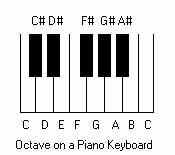


UK Registered Charity Number: 1154107

Conservation by Re-use
Helping churches acquire surplus and/or redundant bells to be hung for
English-style full-circle bell-ringing.



A scale is an ordered arrangement of the notes found in the music of a particular culture. The scales found in Western European music all give prominence to the octave which, as Pythagoras found, is the interval between two notes whose vibrating frequencies are in the ratio 2:1. These notes sound similar to the human ear even though one has a higher pitch than the other; they are both given the same letter name, e.g. "C".



 Index
Next page
Index
Next page
Two "C's" on the piano keyboard are seven white keys apart and the term octave refers to all eight white keys. If the white and black keys are considered, the octave is divided into twelve intervals called semitones. The notes given by the black keys are given the suffix "#" or "b". The sharp (#) sign indicates that the note is a semitone higher in pitch than the note of the preceding letter, conversely a flat (b) sign indicates the note is a semitone lower. Thus the note between C and D may be given as C# or Db.
Rings of bells are usually tuned to the major key, so that the interval in semitones between consecutive bells is the same as the intervals between the consecutive notes C,D,E,F,G,A,B,C. The table shows the interval in semitones between consecutive bells for rings of three to sixteen. It is normal when augmenting rings to add bells to the right hand side of the series, i.e. to add higher pitch bells or "trebles" to the existing ring.
It may be seen from the table that the front eight of a twelve (semitone spacings 2,2,1,2,2,1,2) may be made into a major key octave by replacing the 2nd with a sharp second. Likewise bells 2 through to 9 can be made into a major key by replacing the sixth with a flat sixth.
Some rings of bells are tuned to the minor key, where the semitone spacing from the tenor to the treble of a ring of five bells is: 2,1,2,2 (e.g. notes A,B,C,D,E). Rings of bells in the minor key could be augmented to the major key by adding a tenor bell whose pitch is a tone lower than the existing tenor. In the above example a minor five in the key of A could be augmented to a major key by adding a tenor of note G.